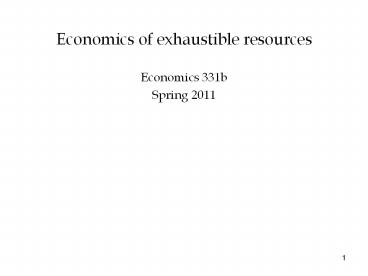Economics of exhaustible resources - PowerPoint PPT Presentation
1 / 24
Title:
Economics of exhaustible resources
Description:
* Standard Tools for Numerical Optimization in Economics and ... how to set efficient prices under Soviet central planning. ... are OIP x RF Cumulative ... – PowerPoint PPT presentation
Number of Views:160
Avg rating:3.0/5.0
Title: Economics of exhaustible resources
1
- Economics of exhaustible resources
- Economics 331b
- Spring 2011
2
Why we will learn numerical optimization
- You will use to build a little economy-climate
change model and optimize your policy. - You have learned the theory (Lagrangeans etc.),
so lets see how it is applied - Optimization is extremely widely used in modern
analysis - - statistics, finance, profit maximization,
engineering design, sustainable systems,
marketing, sports, just everywhere! - It is fun!
3
Standard Tools for Numerical Optimization in
Economics and Environment
- Some kind of Newtons method.
- Start with system z g(x). Use trial values
until converges (if you are lucky and live long
enough). For picture, see http//en.wikipedia.org
/wiki/FileNewtonIteration_Ani.gif - EXCEL Solver, which is convenient but has
relatively low power. - - I will use this for the Hotelling model.
proprietary version is better but pricey and I
sometimes use (Risk Solver Platform. - GAMS software (LP and other) . Has own language,
proprietary software, but very powerful. - - This is used in many economic integrated
assessment models of climate change. GAMS
software. Has own language, proprietary software,
but very powerful. - 4. MATLAB and similar.
4
How to calculate competitive equilibrium
- We can do it by bruit force by constructing many
supply and demand curves. Not fun. - Modern approach is to use the correspondence
principle. This holds that any competitive
equilibrium can be found as a maximization of a
particular system.
5
Economic Theory Behind Modeling
1. Basic theorem of markets as maximization
(Samuelson, Negishi)
Maximization of weighted utility function
Outcome of efficient competitive market (however
complex but finite time)
2. This allows us (in principle) to calculate the
outcome of a market system by a constrained
non-linear maximization.
6
Linear programming problem as applied to
exhaustible resources
7
Simple Example of Hotelling theory
- Lets work through an example
- Assume demand 10 per year (zero price
elasticity) - Resources
- 201 units of 10 per unit oil
- unlimited amount of backstop oil at 100 per
unit - Discount rate 5 per year
- Questions
- What is efficient price and quantity?
8
Screenshot of simple problem
9
Screenshot of solver for simple model
10
Screenshot of shadow price
11
Solution quantities
12
Solution prices
Backstop cost
Market price
Royalty
12
13
Important question to think about
- Recall idea of shadow price.
- Defined as change in objective function for unit
change in a constraint. - LP and shadow price idea were invented by a
Russian mathematician studying how to set
efficient prices under Soviet central planning. - He argued (and it was later proved) that economic
efficiency comes when market prices shadow
prices - This is used in environmental problems and global
warming. - Important question in this context Why does
efficiency price of exhaustible resource rise at
discount rate over time?
14
Arranged marriage of Hotelling and Hubbert
- Lets construct a little Hotelling-style oil
model and see whether the properties look
Hubbertian. - Technological assumptions
- Four regions US, other non-OPEC, OPEC Middle
East, and other OPEC - Ultimate oil resources (OIP) in place shown on
next page. - Recoverable resources are OIP x RF Cumulative
extraction - Constant marginal production costs for each
region - Fields have exponential decline rate of 10 per
year - Economic assumptions
- Oil is produced under perfect competition ?
costs are minimized to meet demand - Oil demand is perfectly price-inelastic
- There is a backstop technology at 100 per barrel
15
Estimates of Petroleum in Place
Department of Energy, Energy Information Agency,
Report DOE/EIA-0484(2008)
16
Petroleum supply data
Sources Resource data and extraction from EIA
and BP costs from WN
17
Demand assumptions
- Historical data from 1970 to 2008
- Then assumes that demand function for oil grows
at 2 percent for year (3 percent output growth,
income elasticity of 0.67). - Price elasticity of demand 0
- Backstop price 100 per barrel of oil
equivalent. - Conventional oil and backstop are perfect
substitutes.
18
Solution technique
19
Picture of spreadsheet
20
Results Price trajectory
21
Shadow prices for oil in 2010
Interpretation what you would pay for 1 barrel
of oil in the ground.
22
Results Price trajectory actual and model
23
Results Output trajectory
How differs from Hubbert theory 1. Much later
peak 2. Not a bell curve slower rise and
steeper decline
24
(No Transcript)
25
Further questions
- Why are actual prices above model calculations?
- Why is there so much short-run volatility of oil
prices? - Since backstop does not now exist, will market
forces induce efficient RD on backstop
technology?

